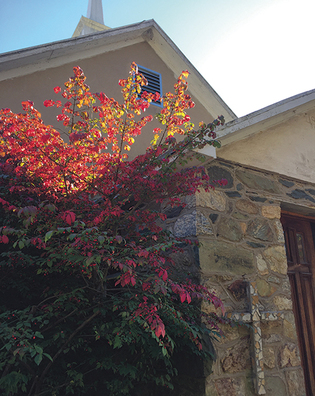 loading
loading
From the EditorGospel and blues, Part 2A student production goes on the road--for history.  Christine HoweAustin Grove Church in Virginia. View full imageDriving south on the dirt roads from the little town of Bluemont, in Loudoun County, Virginia, you enter a region that looks like a strangely expanded country village. The yards are enormous, the size of parks, and they go rolling by one after another, perfectly green, perfectly mowed. Each yard surrounds a very large, well-kept house. Most also have a pasture, with a couple of lively horses. In the midst of this supersized idyll is a tiny church on a little corner of green at a junction of two dirt roads. The area is majority-white now, but it used to be black. The church organization was founded in 1874 by people who had survived slavery. The structure itself was built in 1911 by their families, who would carry in heavy chunks of shale after working their fields. The roof is sagging slightly in one spot, but Austin Grove Church is a beautiful little stone building. Last May, I wrote in this space about Call Me from the Grave, a student-written, student-performed, all-black blues musical at Yale that was one of the best musicals I’ve ever seen. (I counted: I’ve seen about a hundred musicals. Call Me is in my top five.) Not long after, I got a terse email from one Kim Hart ’70, ’80MPPM: “Would you be so kind as to provide me with contact information to the appropriate person. I would like to investigate the possibility of the crew doing a small set of performances in Northern Virginia.” Which is how I got to see Yale students performing Call Me in late October, in a historic stone building with some 40 locals who stood up and clapped—and clapped and clapped—when the show was over. The final number would have blown the church apart if it weren’t an extremely sturdy building: 11 stupendous singers raising their voices to God—because the finale is also a prayer. It was glorious. (I learned later that the sound engineer had turned the mikes off for the finale, presumably so the sound system didn’t blow apart.) At Austin Grove, I got to meet several of the students I’d written about before, including Julian Manresa ’22, who sang the Devil brilliantly; Me’Lena Laudig ’19, who’s now a graduate student at Princeton, but came all the way to Virginia to sing the female lead; Xavier Washington ’20, now a Whiff, who sang bluesman Robert Johnson. And Charlie Romano ’19, the composer, was there to lead the band (of two) and play keyboard. I also met Ron Lincoln, president of the Austin Grove Preservation Foundation, and Kim Hart. Ron is black and quietly dignified; Kim is white, and one of those cheerful people who seem to be laughing most of the time. Before the two days of performances, Kim and Ron had brought the students together with a Loudoun County historian, Jimmy Roberts, who gives tours of the area. He’s in his 80s and forthright about his experiences with Jim Crow. He also told the students about his great-grandmother, who came to live with his family when he was six or seven. She had been enslaved. History lives with us, whether we’re aware of it or not. Ron and Kim brought Yale students to Bluemont to help save one of the better pieces of its history. The ticket sales after expenses, plus donations from people who heard the performances, will keep Austin Grove whole for an entire year. All thanks to some tremendously talented Yale students. Kim admitted to me that he and Ron had taken a risk when they brought the students in. He’d read my rave about Call Me in May, but how could he know if I had a decent ear for music? “We took a flier,” he said. I’m overjoyed that they did.
The comment period has expired.
|
|